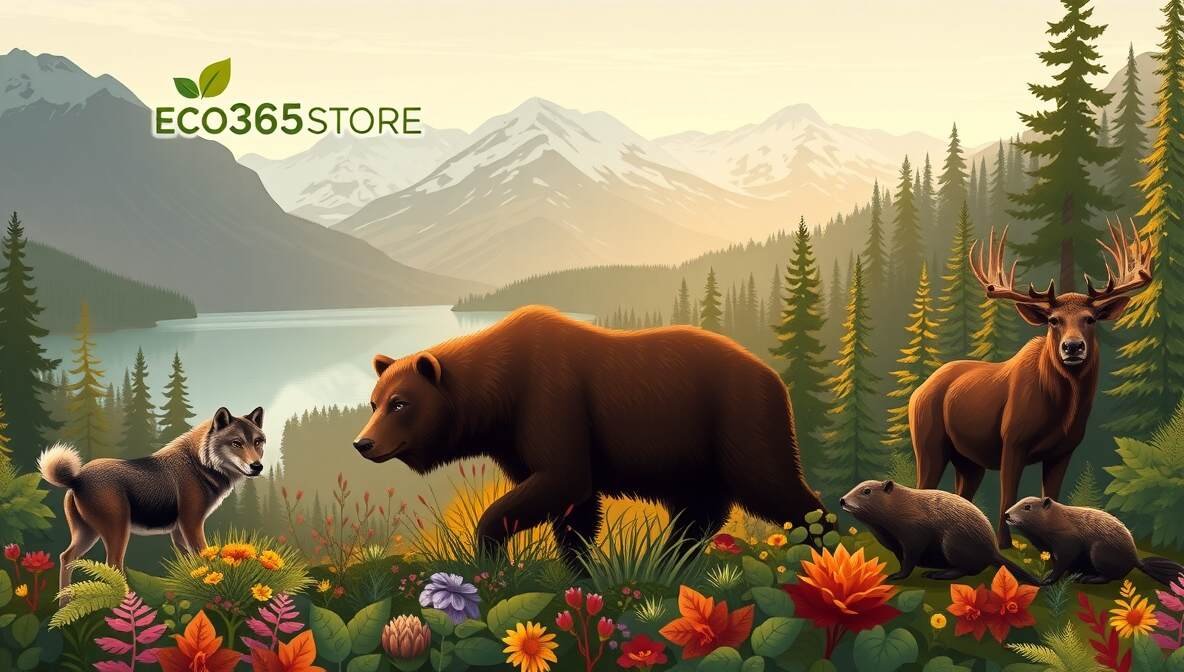Canada is a dream destination for nature lovers and wildlife enthusiasts. With its vast wilderness, diverse landscapes, and thriving ecosystems, it’s easy to see why Canada is celebrated as one of the best places to see wildlife in Canada. From the majestic grizzly bears of British Columbia to the iconic moose wandering through its eastern forests, Canada offers endless opportunities for unforgettable wildlife encounters.
This country’s pristine beauty and commitment to conservation make it a haven for both casual observers and adventurous explorers. With so much to discover, Canada promises a wildlife experience like no other.

Why Canada Is the Best Place to See Wildlife
Canada’s sheer size and varied geography allow it to host an incredible array of ecosystems. From the rugged Rocky Mountains to the serene boreal forests and Arctic tundra, there are habitats for a diverse range of species.
The country has made significant efforts to preserve this biodiversity through extensive national and provincial parks, wildlife sanctuaries, and cutting-edge conservation programs. Iconic species, such as the polar bear, are protected through initiatives like Manitoba’s Polar Bear Conservation Project. Similarly, the reintroduction of bison in Banff National Park underscores Canada’s dedication to restoring native species.
Rich biodiversity and a strong focus on sustainability solidify Canada’s reputation as a top wildlife destination for travelers worldwide.
Top Wildlife Spots in Canada
1. Banff National Park, Alberta
Set in the heart of the Canadian Rockies, Banff is renowned for its breathtaking scenery and abundant wildlife. Visitors may cross paths with elk, mountain goats, and grizzly bears. The turquoise waters of Lake Louise and Moraine Lake also attract a variety of bird species, including ospreys and bald eagles.
2. Churchill, Manitoba
Known as the “Polar Bear Capital of the World,” Churchill is the ultimate destination for spotting these majestic creatures. Visit during the fall months to see polar bears up close as they migrate to Hudson Bay. Churchill is also an excellent place to see beluga whales in the summer.
3. Cape Breton Highlands National Park, Nova Scotia
This picturesque park offers a unique blend of coastal and forest ecosystems. Moose sightings are common, and the Cabot Trail provides incredible vantage points for spotting pilot whales and seabirds like puffins.
4. Pacific Rim National Park Reserve, British Columbia
Located on Vancouver Island, this lush reserve is a haven for marine life and coastal wildlife. Venture to Tofino for a chance to see grey whales, seals, and sea lions. Black bears are also frequently spotted along the shoreline.
5. Yellowknife, Northwest Territories
Yellowknife offers some of Canada’s most thrilling Arctic wildlife experiences. Spotting muskox, Arctic foxes, and the occasional snowy owl in their natural habitat is an unforgettable adventure. Winter visitors can also enjoy the Northern Lights as an extraordinary backdrop.
Best Time of Year to Spot Wildlife in Canada
Canada’s wildlife is active year-round, but the timing of your visit will affect the animals you’re likely to see and the type of experience you’ll have.
- Spring (March–May): Bears emerge from hibernation, and bird migrations are at their peak. Wetlands and forested areas are alive with activity.
- Summer (June–August): Arctic tundra wildlife, such as caribou, comes into view. This is also the best season for whale-watching on the coasts.
- Fall (September–November): Moose and elk are active during their mating season. Polar bears begin their migration, and autumnal colors create stunning photographic opportunities.
- Winter (December–February): Spotting wolves and lynx becomes easier in snowy landscapes, especially in Alberta and the Yukon. Seals and other marine wildlife remain active along Canada’s coasts.
For optimal wildlife spotting, choose early mornings or evenings, as animals are most active during these times.
Animals You Can Expect to See in Canada
Canada is a haven for an array of intriguing species. Among the highlights are:
- Mammals: Moose, polar bears, grizzly bears, wolves, and caribou.
- Marine Life: Beluga whales, grey whales, harbor seals, and orcas.
- Birds: Bald eagles, puffins, great grey owls, and snowy owls.
- Reptiles and Amphibians: The wood turtle and northern leopard frog are particularly fascinating natives.
- Arctic Wildlife: Arctic foxes, muskoxen, and narwhals dominate the northern landscapes.
Each region and ecosystem in Canada hosts unique species, making every wildlife tour a new adventure.
Tips for Safe & Ethical Wildlife Viewing
Make the most of your experience while respecting Canada’s wildlife with these tips:
- Keep Your Distance: Always observe animals from at least 100 meters away, particularly large predators. Use binoculars for close-up views.
- Don’t Interact with Wildlife: Feeding or attempting to touch animals disrupts their natural behavior and endangers their survival.
- Stick to Trails: Off-trail exploration can damage habitats and stress wildlife.
- Travel in Groups: For safety, especially in bear country, travel with others and carry bear spray if applicable.
- Support Local Conservation Efforts: Choose tour operators that prioritize ethical wildlife viewing practices.
Wildlife Photography Tips
Capture stunning images of Canada’s wildlife using these techniques:
- Invest in the Right Lenses: A 200mm or longer telephoto lens will help you photograph animals from a safe distance.
- Get the Lighting Right: Opt for golden hours (sunrise and sunset) for soft, natural light and enhanced colors.
- Stay Silent and Patient: Animals are more likely to approach or exhibit natural behavior when you remain quiet and still.
- Use a Monopod: These are lighter than tripods and easier to handle in remote areas.
- Frame with Context: Include elements of the natural habitat, like the towering Rockies or tranquil wetlands, to add depth.
How to Get to Canada’s Top Wildlife Destinations
Getting to these wild places is easier than you might think:
- By Air: Fly into major international hubs like Vancouver (YVR), Montreal (YUL), or Toronto (YYZ). Regional airports such as Calgary (YYC) and Winnipeg (YWG) provide good access to wildlife hotspots.
- By Car: Renting a car allows you to explore remote locations like Cape Breton Highlands and Banff at your leisure.
- Guided Tours: Opt for eco-friendly tours led by experts for seamless, educational wildlife experiences.
Where to Stay Nearby
Base your wildlife adventure in comfortable accommodations at these options:
- Budget: HI Jasper Hostel provides affordable lodging close to Jasper National Park.
- Mid-Range: Bear Hill Lodge in Banff offers cozy cabins ideal for wildlife enthusiasts.
- Luxury: Churchill Northern Studies Centre immerses visitors in eco-tourism while offering premium polar bear tours.
Affiliate Suggestion:
Book your preferred stay here [#] to enjoy discounted rates.
Nearby Attractions or Activities
Round out your wildlife adventure with these unforgettable experiences:
- Niagara Falls: Spectacular natural wonder. Pair it with birdwatching excursions nearby.
- The Cabot Trail: A scenic drive with abundant wildlife-spotting opportunities.
- Vancouver Aquarium: Explore marine biodiversity through interactive exhibits and educational programs.
Conclusion
Canada is undoubtedly one of the best places to see wildlife. Its sprawling wilderness, thriving ecosystems, and conservation ethos make it ideal for anyone yearning to experience nature at its rawest and most breathtaking. From the polar bears of Churchill to the whales of the Pacific Rim, every encounter promises to be unforgettable.
Start planning your adventure today to explore Canada’s extraordinary wildlife and natural wonders.
FAQs
- What is the best season to see polar bears in Canada?
Visit Churchill, Manitoba, in the fall (October–November) for prime polar bear viewing. - Can I see whales in Canada?
Yes, Canada’s coasts, especially in British Columbia and Newfoundland, are excellent for whale-watching. - Is wildlife watching safe in Canada?
Yes, provided you follow safety guidelines, such as keeping a safe distance and carrying bear spray when needed. - What gear should I bring for wildlife photography?
A telephoto lens, tripod, extra batteries, and weather-resistant equipment are highly recommended. - Are guided wildlife tours worth it?
Absolutely! Guided tours often increase your chances of sightings and provide valuable educational insights.

Anamika is a passionate writer for Eco365Store.com, specializing in topics that inspire a cleaner, greener world. With expertise in home cleaning, recycling, and eco-friendly solutions, she crafts engaging and informative articles that help readers adopt sustainable practices in their daily lives.

